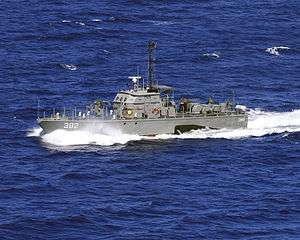BRP Filipino Flojo (PG-386)
 Sister ship BRP Juan Magluyan | |
| History | |
|---|---|
| Name: | BRP Filipino Flojo |
| Operator: | Philippine Navy |
| Identification: | PG-386 |
| Status: | in active service |
| General characteristics | |
| Class and type: | Jose Andrada-class patrol craft |
| Displacement: | 56.4 tons full load |
| Length: | 78 ft 10 in (24.03 m)[1] |
| Beam: | 20 ft 7 in (6.27 m) max[1] |
| Draft: | 5.8 ft (1.8 m)[1] |
| Propulsion: | |
| Speed: | 28 knots (52 km/h) maximum |
| Range: | 1,200 nmi (2,200 km) at 12 knots (22 km/h) |
| Complement: | 12[1] |
| Sensors and processing systems: | Raytheon AN/SPS-64(V)11 Navigation / Surface Search Radar |
| Armament: |
|
BRP Filipino Flojo (PG-386) is a Jose Andrada-class patrol craft of the Philippine Navy. She is currently in active service.
History
In 1989, the Philippines placed an order of 4 fast patrol craft with Trinity-Equitable (formerly Halter-Marine Equitable) for USD9.4 million.[3] The first of the four vessels, arrived on August 20, 1990, was named Jose Andrada. The lead ship of the class was named after Jose Andrada, who was one of the original officers of the Offshore Patrol of the Philippine Commonwealth government.[3] In April 1990, the Philippines ordered an additional ship and 3 more ships in August 1990. In March 1993, eleven more vessels were ordered. A total of 22 ships were acquired by the Philippine Navy by 1999.[3]
Ship Design
Her class was built to U.S. Coast Guard standards, with an aluminum hull and superstructure. In addition, a 4-meter rigid inflatable boat powered by a 40-hp outboard motor is stowed amidships. She has a complement of 12. The ship is equipped with a Raytheon AN/SPS-64(V)11 Navigation/Surface Search Radar, but with a smaller antenna as those used in bigger Philippine Navy ships. Like all other Philippine Navy ships, the entire class was installed with the Philippine Navy Vessel Tracking System (VTS) by the Naval Sea Systems Command.[4]
Armament
The ships of her class are armed with one 25mm Bushmaster chain gun on Mk.38 Mod.0 mount on second and later batches (PG-379 to PG-395), four M2HB Browning 12.7 mm/50 caliber machine guns on Mk.26 mounts, with two positioned forward and two aft; and two M60 7.62 mm/30 caliber machine guns, both mounted amidships. The ship can carry 4,000 rounds of 12.7 mm and 2,000 rounds of 7.62 mm ammunition. A large "Big Eyes" binocular is also carried on tripod mounts, one on the forecastle and one just abaft the mast.[2]
Propulsion
She is powered by two Detroit Diesel 16V-92TA Diesel Engines with a combined power of around 2,800 hp, driving two propellers for a maximum speed of 28 knots (52 km/h). Her maximum range is 1,200 nmi (2,200 km) at 12 knots (22 km/h), or alternatively, 600 nmi (1,100 km) at 24 knots (44 km/h).[2]
Operational History
In May 2018, the BRP Filipino Flojo participated in the Third Combined Maritime Security Activity with the Royal Australian Navy (RAN) along with the BRP General Mariano Alvarez (PS-38), BRP Anastacio Cacayorin (PS-381), BRP Cebu (PS-28) and BRP Dioscoro Papa (PG-381). The RAN sent the vessels HMAS Albany (ACPB 86) and HMAS Glenelg (ACPB 96) for the exercise.[5]
References
- 1 2 3 4 5 Saunders, Stephen: Jane's Fighting Ships 107th Edition 2004–2005. Jane's Information Group Ltd, 2004.
- 1 2 3 4 5 Wertheim, Eric: The Naval Institute Guide to Combat Fleets of the World 15th Edition, page 553. Naval Institute Press, 2007.
- 1 2 3 "Jose Andrada class". Retrieved April 17, 2012.
- ↑ "NASSCOM Unveils PN Vessel Tracking System (VTS)". Philippine Navy Naval Sea Systems Command. 2009. Archived from the original on 2009-02-09. Retrieved 2011-11-24.
- ↑ "RP, Australia Up for Another Maritime Security Activity"